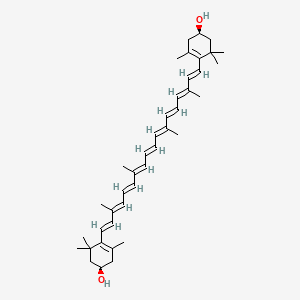Zeaxanthin
Zeaxanthin is a lipid of Prenol Lipids (PR) class. Zeaxanthin is associated with abnormalities such as Disintegration (morphologic abnormality), Alkalemia, Age related macular degeneration, Visual impairment and Consumption-archaic term for TB. The involved functions are known as Signal, Regulation, Energy Transfer, Process and Pigment. Zeaxanthin often locates in Chloroplast thylakoids, reaction center, Tissue membrane, PSII associated light-harvesting complex II and Thylakoid Membrane. The associated genes with Zeaxanthin are PRB2 gene, Structural gene, Polypeptides, Genes, Bacterial and Genes, rRNA. The related lipids are Membrane Lipids, Micelles, Fatty Acids, Lipid Peroxides and monogalactosyldiacylglycerol. The related experimental models are Knock-out.
References related to genes published in Others
| PMID | Journal | Published Date | Author | Title |
|---|---|---|---|---|
| 11729205 | J. Biol. Chem. | 2002 | Ruban AV et al. | Activation of zeaxanthin is an obligatory event in the regulation of photosynthetic light harvesting. |
| 12656178 | Int. J. Syst. Evol. Microbiol. | 2003 | Berry A et al. | Paracoccus zeaxanthinifaciens sp. nov., a zeaxanthin-producing bacterium. |
| 10618204 | Appl. Environ. Microbiol. | 2000 | Lagarde D et al. | Increased production of zeaxanthin and other pigments by application of genetic engineering techniques to Synechocystis sp. strain PCC 6803. |
| 14722117 | J. Biol. Chem. | 2004 | Havaux M et al. | The effect of zeaxanthin as the only xanthophyll on the structure and function of the photosynthetic apparatus in Arabidopsis thaliana. |
| 21106934 | FASEB J. | 2011 | Amengual J et al. | A mitochondrial enzyme degrades carotenoids and protects against oxidative stress. |
| 19376893 | Appl. Environ. Microbiol. | 2009 | Weinert N et al. | Rhizosphere communities of genetically modified zeaxanthin-accumulating potato plants and their parent cultivar differ less than those of different potato cultivars. |
| 20507981 | J. Biol. Chem. | 2010 | Saga G et al. | Mutation analysis of violaxanthin de-epoxidase identifies substrate-binding sites and residues involved in catalysis. |
| 15557295 | J. Exp. Bot. | 2005 | Horton P and Ruban A | Molecular design of the photosystem II light-harvesting antenna: photosynthesis and photoprotection. |
| 15995679 | EMBO Rep. | 2005 | Szabó I et al. | Light and oxygenic photosynthesis: energy dissipation as a protection mechanism against photo-oxidation. |
| 16957020 | J. Exp. Bot. | 2006 | Gerjets T and Sandmann G | Ketocarotenoid formation in transgenic potato. |
| 17194842 | Appl. Environ. Microbiol. | 2007 | Nishizaki T et al. | Metabolic engineering of carotenoid biosynthesis in Escherichia coli by ordered gene assembly in Bacillus subtilis. |
| 22582723 | FEMS Microbiol. Lett. | 2012 | Hameed A et al. | Siansivirga zeaxanthinifaciens gen. nov., sp. nov., a novel zeaxanthin-producing member of the family Flavobacteriaceae isolated from coastal seawater of Taiwan. |
| 26541886 | Prog Retin Eye Res | 2016 | Bernstein PS et al. | Lutein, zeaxanthin, and meso-zeaxanthin: The basic and clinical science underlying carotenoid-based nutritional interventions against ocular disease. |
| 27538825 | J. Lipid Res. | 2016 | Thomas SE and Harrison EH | Mechanisms of selective delivery of xanthophylls to retinal pigment epithelial cells by human lipoproteins. |
| 27389691 | J. Lipid Res. | 2016 | Palczewski G et al. | Genetic dissection in a mouse model reveals interactions between carotenoids and lipid metabolism. |
| 25972257 | Ophthalmology | 2015 | Glaser TS et al. | The Association of Dietary Lutein plus Zeaxanthin and B Vitamins with Cataracts in the Age-Related Eye Disease Study: AREDS Report No. 37. |
| 24829491 | Am. J. Clin. Nutr. | 2014 | Koo E et al. | Macular xanthophylls, lipoprotein-related genes, and age-related macular degeneration. |
| 27620066 | Biochim. Biophys. Acta | 2016 | Matuszyńska A et al. | A mathematical model of non-photochemical quenching to study short-term light memory in plants. |
